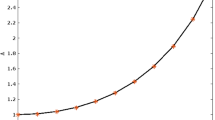Abstract
The work presented in this publication can be categorized among domain decomposition methods of the dual Schur type applied to structural dynamics. This approach leads to lower CPU times and better control of the accuracy of the time discretization and allows to take into account multi-time-scale effects which arise in transient structural dynamics. In order to consider incompatible time scales, one has to enforce continuity at the interfaces between the subdomains. Here, we propose a general formalism which enables the coupling of subdomains with their own numerical time integration scheme. The proposed method enables one to take into account possible nonlinearities which may present different time scale between the subdomains in a general manner for a wide range of time numerical scheme. This method also offers an important improvement for industrial software with easy implementation. Linear and nonlinear numerical examples are proposed in order to show the efficiency and the robustness of the method.
Similar content being viewed by others
References
Belytschko T, Mullen R (1976) Mesh partitions of explicit-implicit time integration In: Proceedings US–Germany symposium on formulations and computationnal algoritms in finite element analysis
Belytschko T, Mullen R (1978) Stability of explicit-implicit mesh partitions in time integration. Int J Numer Methods Eng 12: 1575–1586
Liu WK, Belytschko T (1982) Mixed-time implicit-explicit finite elements for transient analysis. Comput Struct 15: 445–450
Liu WK, Belytschko T, Zhang YF (1984) Implementation and accuracy of mixed-time implicit-explicit methods for structural dynamics. Comput Struct 19: 521–530
Belytschko T, Liu WK, Smolinski P (1987) Stability of multi-time step partitioned transient analysis for first-order systems of equation. Comput Methods Appl Mech Eng 65: 115–125
Ben Dhia H. (1998) Multiscale mechanical problems: the Arlequin method. Comptes Rendus de l’Académie des Sci Ser IIB Mech Phys Astron 12: 899–904
Bourel B (2006) Calcul multi-domaines et approches multi-échelles pour la simulation de crashs automobiles, Thèse de doctorat. Institut National des Sciences Appliquées de Lyon
Bourel B, Combescure A, Valentin LD (2006) Handling contact in multi-domain simulation of automobile crashes. Finite Elements Analy Des 42: 766–779
Cavin P, Gravouil AA, Combescure A (2005) Automatic energy conserving space-time refinement for linear dynamic structural problems. Int J Numer Methods Eng 50: 304–321
Combescure A, Gravouil A (2002) A numerical scheme to couple subdomains with different time-steps for predominantly linear transient analysis. Comput Methods Appl Mech Eng 191: 1129–1157
Daniel WJT (1998) A study of the stability of subcycling algorithms in structural dynamics. Comput Methods Appl Mech Eng 156: 1–13
Dodds JRH, Lopez LA (1980) Substructuring in linear and nonlinear analysis. Int J Numer Methods Eng 15: 583–597
Farhat C, Roux F-X (1991) A method of finite element tearing and interconnecting and its parallel solution algorithm. Int J Numer Methods Eng 32: 1205–1227
Farhat C, Crivelli L, Geradin M (1993) On the spectral stability of time integration algorithms for a class of constrained dynamics problems. In: Collection of technical papers AIAA/ASME structures, structural dynamics and materials conference. AIAA: Washington DC, USA, pp 80–97
Farhat C, Crivelli L, Roux F-X (1994) Transient FETI methodology for large-scale parallel implicit computations in structural mechanics. Int J Numer Methods Eng 37: 1945–1975
Faucher V, Combescure A (2004) Local modal reduction in explicit dynamics with domain decomposition. Part 1: extension to subdomains undergoing finite rigid rotations. Int J Numer Methods Eng 60: 2531–2560
Gérardin M, Rixen D (1996) Théorie des vibrations—application à la dynamique des structures (2ème édition). Masson Editions, Paris
Glowinski R, Le Tallec P (1990) Augmented lagrangian interpretation of the non-overlapping schwarz alternating method In: Domain decomposition method. SIAM, Philadelphia, pp 224–231
Gravouil A (2000) Méthode multi-échelles en temps et en espace avec décomposition de domaines pour la dynamique non linéaire des structures. Thèse de doctorat. Ecole Normale Supérieure de Cachan
Gravouil A, Combescure A (2001) A multi-time-step explicit-implicit method for non-linear structural dynamics. Int J Numer Methods Eng 50: 199–225
Herry B (2002) Développement dune approche multiéchelle parallèle pour la simulation de crash automobile non linéaire des structures. Thèse de doctorat. Ecole Normale Supérieure de Cachan
Herry B, Di Valentin L, Combescure A (2002) An approach to the connection between subdomains with non-matching meshes for transient mechanical analysis. Int J Numer Methods Eng 55: 973–1003
Hughes TJR, Liu WK (1978) Implicit-Explicit finite elements in transient analysis: stability theory. ASME J Appl Mech 45: 371–374
Hughes TJR, Liu WK (1978) Implicit-Explicit finite elements in transient analysis: implementation and numerical examples. ASME J Appl Mech 45: 375–378
Joly P, Rodrìguez J (2005) An error analysis of conservative space-time mesh refinement methods for the 1D wave equation. SIAM J Numer Anal 43: 825–859
Krenk S (2007) Energy conservation and high-frequency damping in numerical time integration. In: Computational Methods in Structural Dynamics and Earthquake Engineering; Rethymno, Crete, Greece, 12
Magoules F, Roux FX (2006) Lagrangian formulation of domain decomposition methods: a unified theory. Appl Math Model 30: 593–615
Newmark NM (1959) A method of computation for structural dynamics. J Eng Mech Div ASCE 85: 67–94
Prakash A, Hjelmstad KD (2004) A FETI-based multi-time-step coupling method for Newmark schemes in structural dynamics. Int J Numer Methods Eng 61: 2183–2204
Schwarz HA (1870) Über einen Grenzübergang durch alternierendes Verfahren. Vierteljahrssch der Naturforsch Ges Zür 15: 272–286
Simo JC, Wong KK (1991) Unconditionally stable algorithms for rigid body dynamics that exactly preserve energy and momentum. Int J Numer Methods Eng 31: 19–52
Author information
Authors and Affiliations
Corresponding author
Rights and permissions
About this article
Cite this article
Mahjoubi, N., Gravouil, A. & Combescure, A. Coupling subdomains with heterogeneous time integrators and incompatible time steps. Comput Mech 44, 825–843 (2009). https://doi.org/10.1007/s00466-009-0413-4
Received:
Accepted:
Published:
Issue Date:
DOI: https://doi.org/10.1007/s00466-009-0413-4




